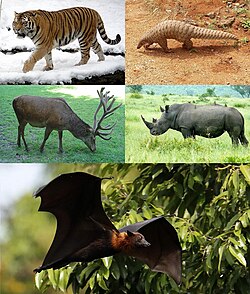| Scrotifera Temporal range: Late Cretaceous to present | |
|---|---|
 | |
| From top to right: tiger, Indian pangolin, red deer, white rhino and Lyle's flying fox. Representing the living orders: Carnivora, Pholidota, Artiodactyla, Perissodactyla and Chiroptera, comprising Scrotifera. | |
| Scientific classification | |
| Kingdom: | Animalia |
| Phylum: | Chordata |
| Class: | Mammalia |
| Superorder: | Laurasiatheria |
| Clade: | Scrotifera Waddell et al., 1999 [2] |
| Subgroups | |
[see classification] | |
| Synonyms | |
| |
Scrotifera ("scrotum bearers") is a clade of placental mammals that groups together grandorder Ferungulata, Chiroptera (bats), other extinct members and their common ancestors. The clade Scrotifera is a sister group to the order Eulipotyphla (true insectivores) based on evidence from molecular phylogenetics, [2] and together they make superorder Laurasiatheria. The last common ancestor of Scrotifera is supposed to have diversified ca. 73.1 [4] to 85.5 [5] million years ago.